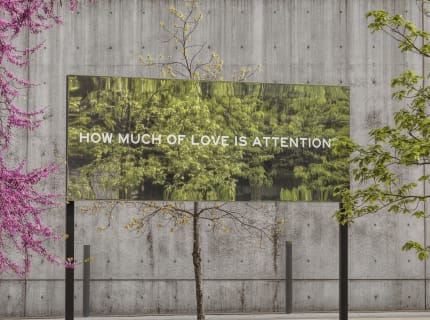IN DISCUSSION
john ros / As I wander through your website, which is a beautiful archive of your work, it’s exciting to see everything come together in a culmination of the everyday — every action — all interactions — regardless of how grand or minute, complex or simple. Moments reverberate off one other and illustrate an exhaustive commitment to reflection, surroundings and momentum — but also pause. There is a timelessness, which might be odd, because your work happens in real time — here and now — which is present then past. There is also rhythm — moments click metronome beats as movements sync between performer and participant-turned-performer. Text follows us consistently — through spaces, public and private; it envelops and fills, all while keeping time and key.
I settle on your statement, which is where I would like to start: “the potential of the everyday as a catalyst for intimacy.” When you speak of intimacy, I imagine a viewer’s connection to the work/experience; our connections to space, place, time; our connections to our specific past/lineage; and our connections to each other. Are these the intimacies you are referring to? Which feels most in line to your thought process and aim?
I also love the notion that your work is “not seeking to invent, but to reveal.” This feels concrete yet lyrical. Would it be safe to say that YOU are also not seeking to invent, but to reveal? Your choice of “My work… ” in that statement is very important, but I imagine as a multiform conceptual artist ‘the artist’ and ‘the work’ may share common space? How much connectivity exists between the self and the artist — the everyday and the studio practice?
Chloë Bass / Well, thank you first for this description of my website, which has certainly never, to my knowledge, inspired such a poetic response before. Something I reflect on a lot, often when talking to students (my own, or when I’m a visiting artist at other schools), is some feedback that I got about an old version of my website while I was in the AIM program at the Bronx Museum. The late, great Jane Farver had come in to give the cohort of artists advice about our websites, which she had looked at carefully in advance of her visit. When it came time to discuss mine, she said, among other things, the very succinct statement, “pictures of people talking are boring.”
I think there’s a tendency in the fields of social practice and performance to offer documentation of a work as a stand-in for an experience that’s really only experienced by those who were present. Of course other artists document their work, too: painters and sculptors offer installation and detail view images of pieces that are certainly very different in all kinds of ways (color, scale, texture, to name a few) when they’re experienced in a physical space. But I think Jane was right: there is something uniquely boring about documentation of bodies doing something together that you, the viewer, were unable to share or participate in.
None of this is really an answer to the question that you asked, which is the connection between the everyday and the studio practice — or, really, the connection between my self and my work. When I did more performance-based work that included, or featured, me as a performer, I sometimes got funny feedback like, “I don’t really know where you are in your work,” to which the answer seemed obvious: I’m right here. Like: literally, my body and voice are right here in front of you, that’s where I am. But that’s not what people mean when they say things like that; what they mean is more, like, “I didn’t get that you were emotionally present in this piece you presented,” or: “the emotions of this piece that you presented didn’t quite connect for me, so I felt like they must have been absent.”
Now, when I produce more text-based, conceptual and public work, I face a different, interesting problem. Because of the relative intimacy of the text — words that, regardless of the scale on which they appear, speak to the inner parts of people that often remain secret even to themselves — viewers often feel like they know me, or know something meaningful about me, after seeing/reading a particular piece or project. And honestly, although the text is based in feelings, I never said to anyone that they were my feelings. I never promised that these words were about me. But because they really do seem to reach people, viewers assume that I am highly present in them. Which I am, but maybe not in the ways you might think.
Nat Trotman, who has spoken with me about my work a few times, once joked that my practice is “inter-studio” — rather than studio, or post-studio. I took it upon myself to come up with a definition, as follows: inter-studio, adjective: the state of being between things. “I moved out of my previous workspace and I don’t yet know where the next one will be.” Inter-studio, noun: the ability to work from anywhere. “I just made art progress on the subway,” or “I get my best material from the public.” In the inter-studio reality, the separation between art and life can be thin, for sure. But that doesn’t mean that just because I’m the artist, it’s my life that becomes the material, or that all life is subject for inclusion in the work. Like any other creative practitioner, I edit, refine, select, reject, and shape through my work’s intentions; I say “my work’s,” because those intentions are not always, or even often, synonymous with my own.
...
Read full article at studioELL.org.

